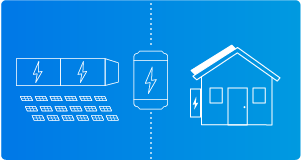The vast majority of energy storage systems installed at homes and businesses in the US are paired with solar. And there’s a good reason for this trend: most people install batteries for backup and if you install a standalone battery, you’ll have no way to recharge your battery after you’ve depleted it until your utility restores electrical service.
That said, there are a few instances where installing a standalone battery might make sense. Here are some questions to consider as you decide whether standalone storage or solar-plus-storage is right for you.

If you’re like most solar shoppers, you’re considering an energy storage system primarily for resilience: as a source of backup power during outages. Standalone storage may be able to help provide backup power but with one important caveat: if you install storage without solar, you’ll have no way to recharge your battery while the grid is still down. In other words, if you frequently experience brief outages–anywhere from a few minutes to a few hours long–a standalone energy storage system can provide added peace of mind by keeping your home running even during an outage. However, if you experience longer outages–lasting several hours to several days–then the benefits of standalone storage are very limited, and you’ll want to pair your battery with solar panels so that you can continue to charge and discharge your battery indefinitely even when the grid is down.
Final verdict: if you experience short durations, standalone storage may be a good fit for you. If outages in your area can stretch to a day or longer, you’ll need to pair storage with solar to keep the lights on.
If you’re interested in installing energy storage for the financial benefits, the biggest variable to consider is the structure of your rate plan. There are two primary ways that batteries can help you lower your electric bills, regardless of whether you are installing a standalone battery or solar-plus-storage: by reducing your peak demand if you have demand charges or by shifting your consumption from the grid to less pricey times if you’re on a time-of-use (TOU) rate.
The question of how much you can save on a demand charge rate is a tricky question whose answer will be unique to each battery installation and each person or business. However, depending upon your consumption habits and the structure of your electricity bill, both standalone storage and solar-plus-storage may be able to help you save. For instance, if you use a consistent amount of electricity during working hours but have a few minutes or a couple of hours of higher usage per day, week, or month and if your utility has a big difference between your peak demand rate and your off-peak demand rate, then standalone storage can definitely help you to mitigate demand charges. This helps explain why more than half of non-residential energy storage installations in California are standalone storage.
The question of how much you can save on a TOU rate is a much clearer question to answer: the key variable is the difference between your peak rate and your off-peak rate. For instance, typical customers of Southern California Edison (SCE) pay 17 cents per kilowatt-hour (c/kWh) for electricity in super off-peak periods in the winter and 30 c/kWh in mid-peak periods. In the summer, they typically pay 23 c/kWh during off-peak periods and 49 c/kWh in peak periods. In other words, a difference of 13 and 25 c/kWh between the lowest and highest cost electricity, by season. A typical battery will store between 10 and 15 kilowatt-hours of electricity, so if you can shift 10 kWh of usage from the highest cost hours to the lowest cost hours, you’d save $1.30 per day in the winter and $2.50 per day in the summer. That may not sound like much, but if you can avoid an average of $2 per day every weekday of the year, that’s bill savings of over $500 per year!
Importantly, the calculation above assumes that you have a standalone storage system. If you install solar-plus-storage, then you can charge the battery directly from your solar panels, meaning instead of shifting from using electricity (or storing it) during the lowest price period during the day, you’re actually storing no-cost solar energy. In other words, instead of saving $1.30 to $2.50 per day, you’re actually able to avoid $3.00 per day in the winter (10 kWh at 30 c/kWh) and $4.90 per day in the summer (10 kWh at 49 c/kWh). These differences add up fast: with solar and storage your annual TOU bill savings could be over $1,000, double the bill savings with just standalone storage.
Final verdict: both standalone storage and solar-plus-storage can help you save on electricity bills with demand charges or TOU rates, but solar-plus-storage should save you more on TOU rates.